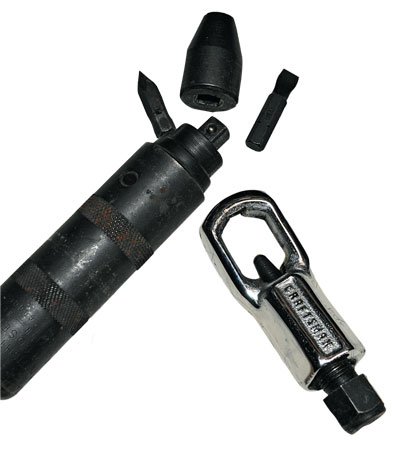
Impact driver
If not adequately protected, anything aboard a vessel that’s made of ordinary carbon steel or iron will, inevitably, rust or seize. And sometimes even protected hardware, like a galvanized anchor shackle, may resist all efforts at disassembly. Before delving into options for freeing stuck gear, however, we’ll discuss methods for preventing this entirely avoidable scenario. Until it’s too late, we often ignore the fact that if left uncoated or untreated, mild steel will rust.
Many, but not all, mild-steel nuts and bolts are plated with cadmium or a chrome alloy to resist this natural onslaught. Plating quality plays a large role in how well hardware holds up to the elements, but it’s tough to evaluate plating by simply inspecting it. So play it safe and thoroughly paint, or coat with corrosion inhibitor, all mild-steel hardware. Consider using an anti-seize compound on threads, particularly for galvanized shackles. But beware: Such compounds may loosen fasteners, which in turn makes such locking mechanisms as seizing wire, lock washers, or nylon locking nuts very important.
Anti-seize compounds that utilize copper are unsuitable for aluminum applications. For fasteners that aren’t routinely disassembled, use a thread-locking compound such as Loctite, which prevents fasteners from unscrewing themselves and protects thread interfaces from moisture and seizing. When stainless-steel fasteners are screwed into an aluminum substrate, avoid seizing by excluding moisture from the interface. I’ve had great success using either Loctite or simple polysulfide or polyurethane sealant.
There are several options for removing a badly rusted or seized fastener. While there are scores of penetrating fluids on the market, I keep returning to PB Blaster (www.pbblaster.com). Despite the product’s gaudy label, it works well, and many mechanics swear by it. Keep a can aboard.
Your next ally in this fight is heat. Heating a fastener—for instance, a nut or substrate around a bolt—will cause it to expand, often enough to loosen the grip of years’ worth of rust. If you use a torch, do so with extreme caution, and make certain that no flammable materials, like rags soaked in penetrating oil, are nearby. Always keep a fire extinguisher handy.
If heat fails, try an impact driver, a fixture in auto-repair shops. While most models rely on compressed air, versions are specifically made to address stuck fasteners; these operate on a cam principal, and their energy is derived from the blow of a hammer. I’ve used mine many times—it’s compact, inexpensive, and invaluable. Finally, if the stubborn fastener is a nut that won’t budge, you can use a tool called a Nut Cracker, made by Craftsman. Nut Crackers rely on a hardened-steel, chisel-like device that’s driven into the nut to split it. When it comes to removing frozen and rusted fasteners, if you’ve got the will, there’s usually a way.
Steve D’Antonio offers services for boat owners and buyers through Steve D’Antonio Marine Consulting ().








